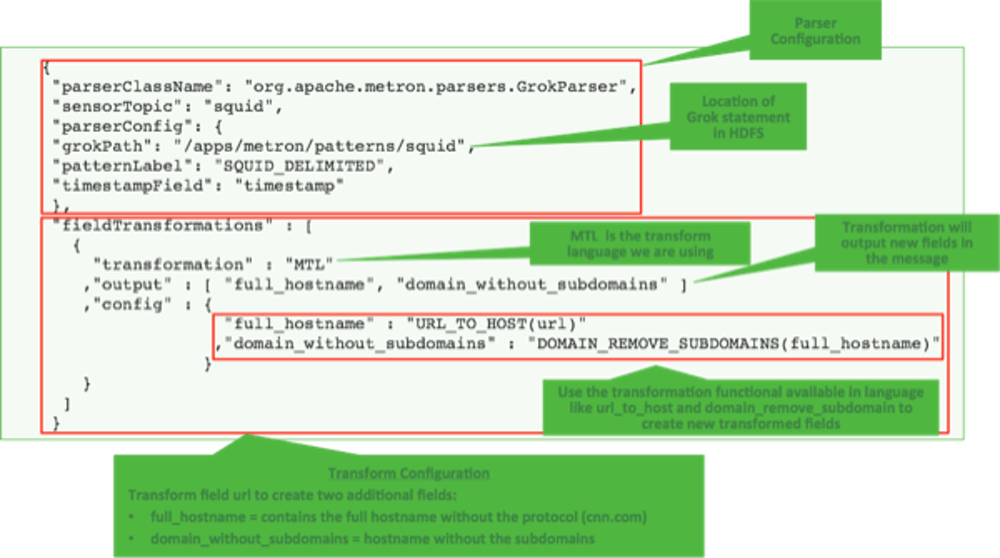Example: fieldTransformation Configuration
The fieldTransformation is a complex object which defines a transformation that can be done to a message.
In this example, the host name is extracted from the URL by way of the URL_TO_HOST
function. Domain names are removed by using DOMAIN_REMOVE_SUBDOMAINS, thereby creating two
new fields (full_hostname and
domain_without_subdomains) and adding them to each message.
Configuration File with Transformation Information

The format of a fieldTransformation is as follows:
- input
-
An array of fields or a single field representing the input. This is optional; if unspecified, then the whole message is passed as input.
- output
-
The outputs to produce from the transformation. If unspecified, it is assumed to be the same as inputs.
- transformation
-
The fully qualified class name of the transformation to be used. This is either a class which implements FieldTransformation or a member of the FieldTransformations enum.
- config
-
A String to Object map of transformation specific configuration.
- REMOVE
-
This transformation removes the specified input fields. If you want a conditional removal, you can pass a Metron Query Language statement to define the conditions under which you want to remove the fields.
The following example removes
field1unconditionally:{ ... "fieldTransformations" : [ { "input" : "field1" , "transformation" : "REMOVE" } ] }The following example removes field1 whenever field2 exists and has a corresponding value equal to 'foo':
{ ... "fieldTransformations" : [ { "input" : "field1" , "transformation" : "REMOVE" , "config" : { "condition" : "exists(field2) and field2 == 'foo'" } } ] } - IP_PROTOCOL
-
This transformation maps IANA protocol numbers to consistent string representations.
The following example maps the
protocolfield to a textual representation of the protocol:{ ... "fieldTransformations" : [ { "input" : "protocol" , "transformation" : "IP_PROTOCOL" } ] } - STELLAR
- lo
-
This transformation executes a set of transformations expressed as Stellar Language statements.
The following example adds three new fields to a message:
- utc_timestamp
-
The UNIX epoch timestamp based on the timestamp field, a dc field which is the data center the message comes from and a dc2tz map mapping data centers to timezones.
- url_host
-
The host associated with the url in the url field.
- url_protocol
-
The protocol associated with the url in the url field.
{ ... "fieldTransformations" : [ { "transformation" : "STELLAR" ,"output" : [ "utc_timestamp", "url_host", "url_protocol" ] ,"config" : { "utc_timestamp" : "TO_EPOCH_TIMESTAMP(timestamp, 'yyyy-MM-dd HH:mm:ss', MAP_GET(dc, dc2tz, 'UTC') )" ,"url_host" : "URL_TO_HOST(url)" ,"url_protocol" : "URL_TO_PROTOCOL(url)" } } ] ,"parserConfig" : { "dc2tz" : { "nyc" : "EST" ,"la" : "PST" ,"london" : "UTC" } } }Note that the dc2tz map is in the parser config, so it is accessible in the functions.

